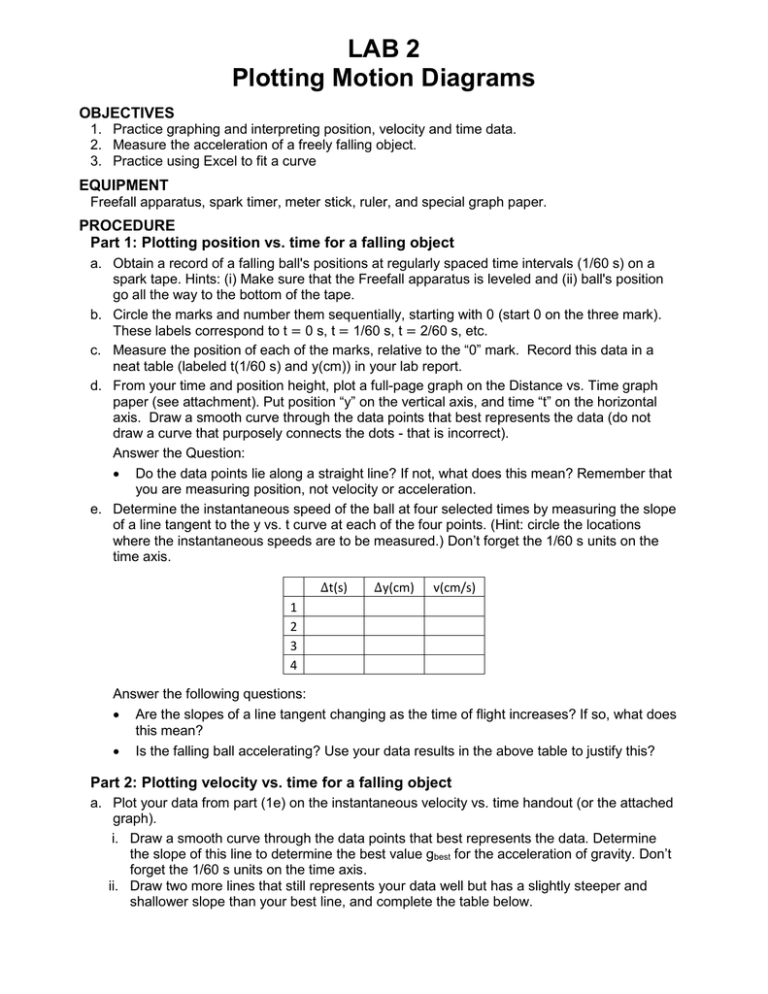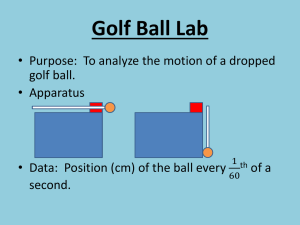LAB 2 Plotting Motion Diagrams OBJECTIVES
advertisement

LAB 2 Plotting Motion Diagrams OBJECTIVES 1. Practice graphing and interpreting position, velocity and time data. 2. Measure the acceleration of a freely falling object. 3. Practice using Excel to fit a curve EQUIPMENT Freefall apparatus, spark timer, meter stick, ruler, and special graph paper. PROCEDURE Part 1: Plotting position vs. time for a falling object a. Obtain a record of a falling ball's positions at regularly spaced time intervals (1/60 s) on a spark tape. Hints: (i) Make sure that the Freefall apparatus is leveled and (ii) ball's position go all the way to the bottom of the tape. b. Circle the marks and number them sequentially, starting with 0 (start 0 on the three mark). These labels correspond to t = 0 s, t = 1/60 s, t = 2/60 s, etc. c. Measure the position of each of the marks, relative to the “0” mark. Record this data in a neat table (labeled t(1/60 s) and y(cm)) in your lab report. d. From your time and position height, plot a full-page graph on the Distance vs. Time graph paper (see attachment). Put position “y” on the vertical axis, and time “t” on the horizontal axis. Draw a smooth curve through the data points that best represents the data (do not draw a curve that purposely connects the dots - that is incorrect). Answer the Question: Do the data points lie along a straight line? If not, what does this mean? Remember that you are measuring position, not velocity or acceleration. e. Determine the instantaneous speed of the ball at four selected times by measuring the slope of a line tangent to the y vs. t curve at each of the four points. (Hint: circle the locations where the instantaneous speeds are to be measured.) Don’t forget the 1/60 s units on the time axis. ∆t(s) ∆y(cm) v(cm/s) 1 2 3 4 Answer the following questions: Are the slopes of a line tangent changing as the time of flight increases? If so, what does this mean? Is the falling ball accelerating? Use your data results in the above table to justify this? Part 2: Plotting velocity vs. time for a falling object a. Plot your data from part (1e) on the instantaneous velocity vs. time handout (or the attached graph). i. Draw a smooth curve through the data points that best represents the data. Determine the slope of this line to determine the best value gbest for the acceleration of gravity. Don’t forget the 1/60 s units on the time axis. ii. Draw two more lines that still represents your data well but has a slightly steeper and shallower slope than your best line, and complete the table below. ∆t(s) ∆v(cm/s) a(cm/s2) Best 1 2 iii. Estimate the acceleration’s “standard deviation” from your slope spread and write out your best estimate and its range as “abest ± SD.” iv. Put your result on the whiteboard as well as on the Results Sheet on the instructor’s computer so that we can get a class average gavg and a standard deviation σg using Excel. v. Set up and draw a “confidence interval” gavg ± σg . Does gaccepted = 981 cm/s2 fall inbetween or outside the confidence interval? If it falls in-between, then the accepted value is consistent with the class’ experimental results. If it falls outside, the accepted value is not consistent Answer the Questions: Why do your four speed values not lie exactly along a straight line? Explain. Does your best fit line of the data go through the origin? Explain. Is your best fit line a linear line? If so, what does this mean about the velocity and acceleration of the ball? Explain.




